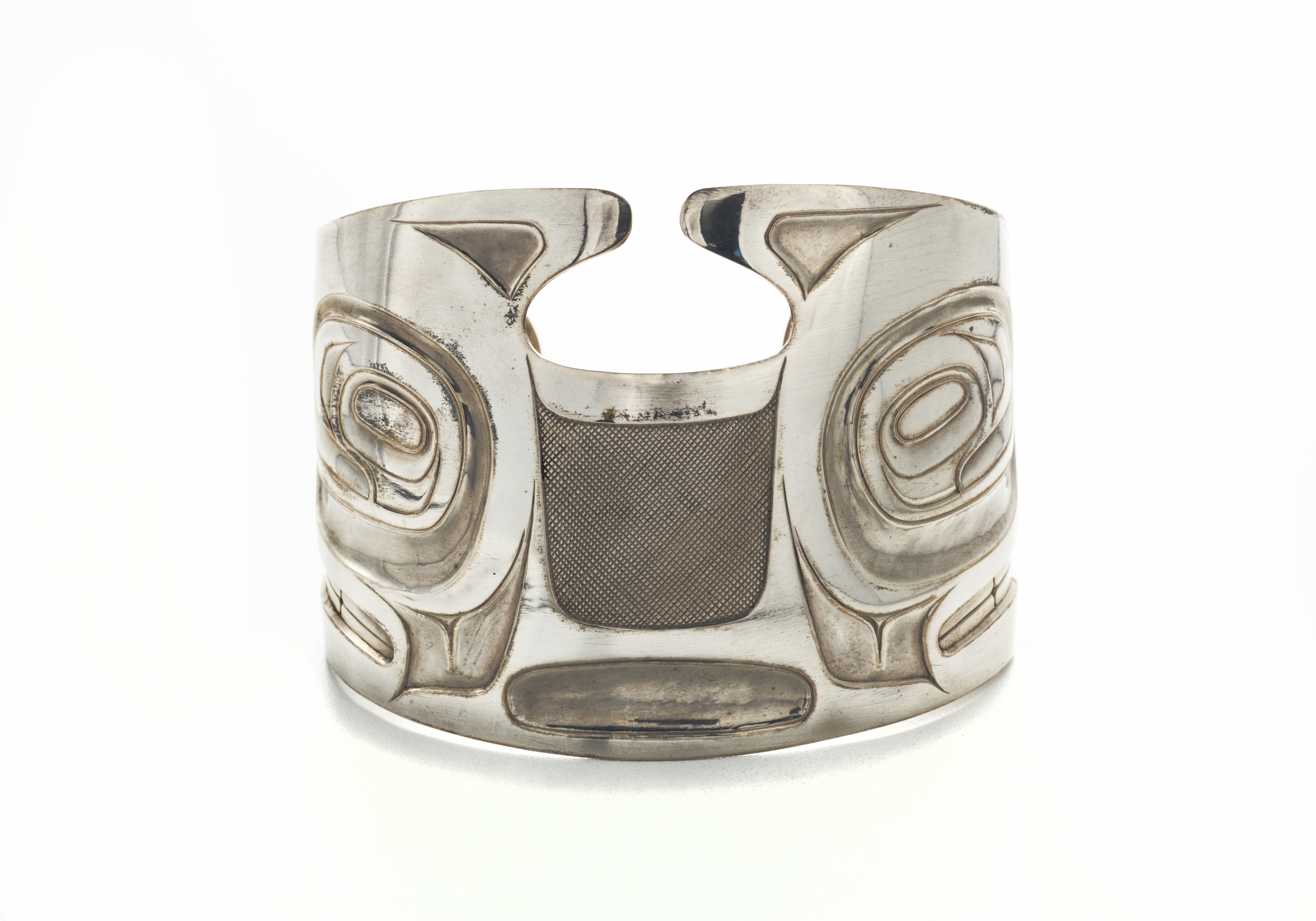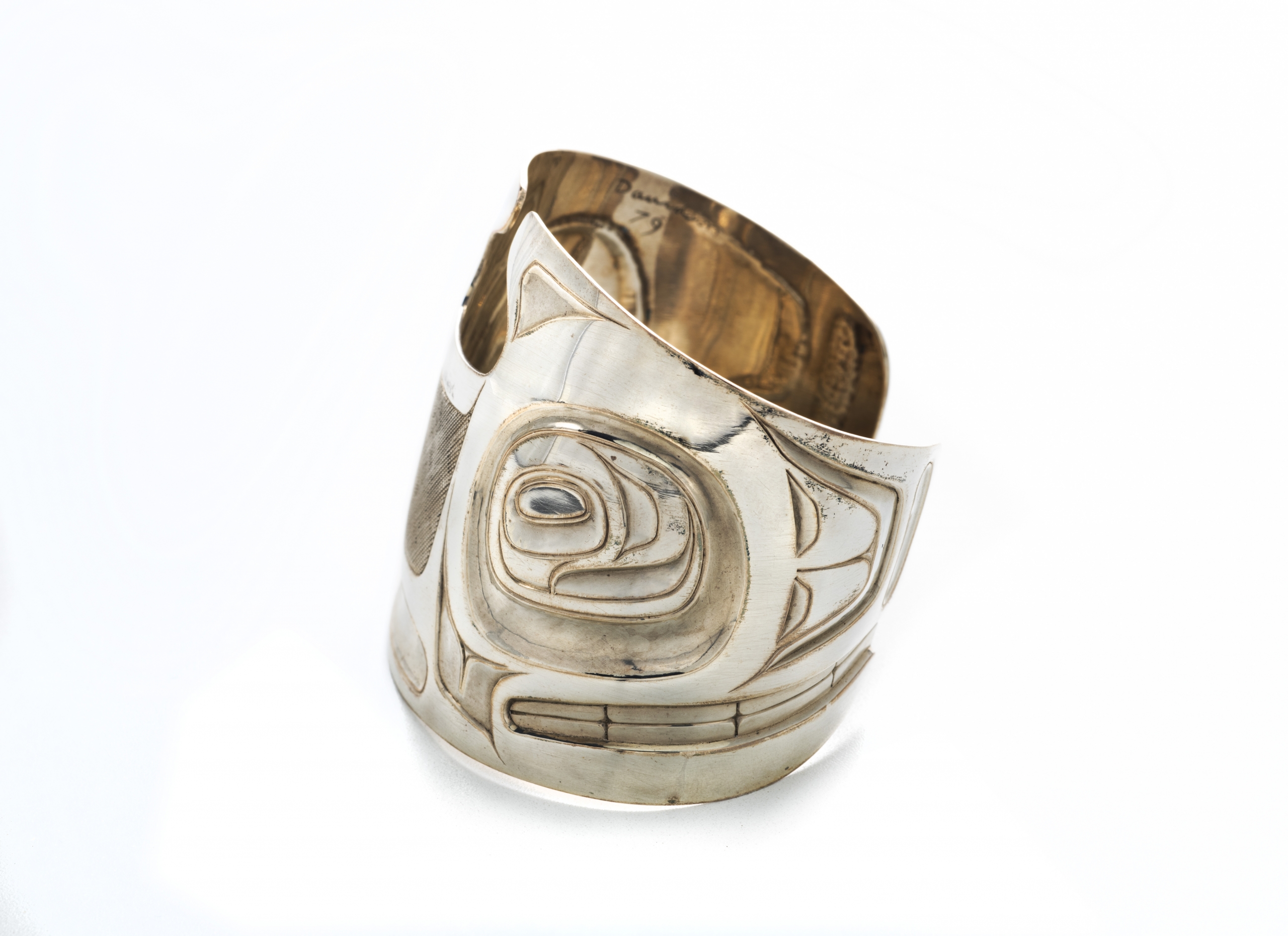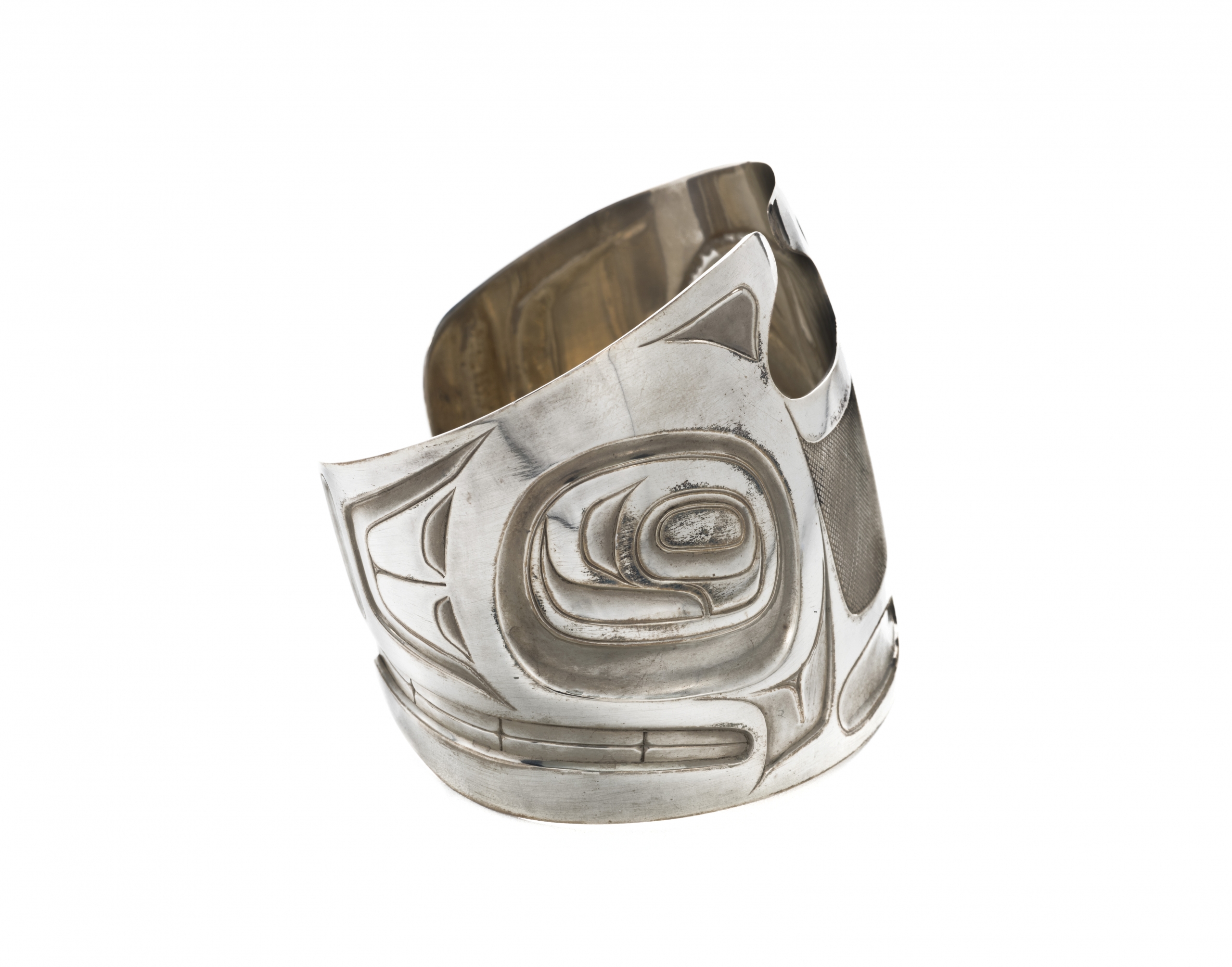Bracelet
Artifact
Image
Video
Audio
 Activities
Activities
LOOK
This dáalaa stlágee (silver bracelet) has been carved in formline style. Look closely at the designs, and the shape of the stláagaa (bracelet). What do you think these aspects represent? Read the historical context provided to verify your answers.
THINK
This dáalaa stlágee (silver carved bracelet), made in 1979, was carved in the traditional X̱aaydaa (Haida) formline style that’s found on much older pieces. What does that tell you about how Haida art has both changed and stayed the same over time?
Details
 Materials
Materials - Silver
Historical Context
Choose one of the three levels below to match your needs.
- Guud San Glans Robert Davidson made this dáalaa stlágee (carved silver bracelet). It has a formline design of a sG̱áan (killer whale).
- Some Haida stlágaa (bracelets) feature carved family crests and symbols.
- The tradition of carving stlágaa (bracelets) using formline design to depict family and personal crests continues today.
Guud San Glans Robert Davidson made this dáalaa stlágee (carved silver bracelet). It has a formline design of a sG̱áan (killer whale).
Artists carve stlágaa (bracelets) for themselves, for family members and friends as gifts, or for sale. When carved for wear and display in the community, stlágaa (bracelets) can represent the wearers’ crests — as symbols of their family or ancestral line, they are markers of identity and status.
The tradition of carving stlágaa (bracelets) using formline design to depict family and personal crests continues today.
Guud San Glans Robert Davidson made this dáalaa stlágee (carved silver bracelet), using formline design to depict a sG̱áan (killer whale). Historically, artists melted and pounded down American silver dollars and other metals acquired through trade, and remade them into bracelets like this. Today, artists order their silver from a variety of suppliers.
Artists carve stlágaa (bracelets) for themselves, for family members and friends as gifts, or for sale. When carved for wear and display in the community, bracelets are intended to represent the wearers’ crests — as symbols of their family or ancestral line, they are markers of identity and status. Before colonization, high-ranking Haida men and women wore kid (tattoos) of familial crests. During the late 19th century and into the 20th — the years of missionization and enforcement of the federal potlatch ban — dáalaa stlágee (silver bracelets) were made and worn as a means to display crests at a time when kid (tattoos) were discouraged by missionaries.
As works of art, but also as a means of showing resistance against cultural oppression, bracelets could be commissioned, or gifted as part of potlatch celebrations.
The tradition of carving stlágaa (bracelets) using formline design to depict family and personal crests continues today.
- Guud San Glans Robert Davidson made this dáalaa stlágee (carved silver bracelet). It has a formline design of a sG̱áan (killer whale).
- Some Haida stlágaa (bracelets) feature carved family crests and symbols.
- The tradition of carving stlágaa (bracelets) using formline design to depict family and personal crests continues today.
Guud San Glans Robert Davidson made this dáalaa stlágee (carved silver bracelet). It has a formline design of a sG̱áan (killer whale).
Artists carve stlágaa (bracelets) for themselves, for family members and friends as gifts, or for sale. When carved for wear and display in the community, stlágaa (bracelets) can represent the wearers’ crests — as symbols of their family or ancestral line, they are markers of identity and status.
The tradition of carving stlágaa (bracelets) using formline design to depict family and personal crests continues today.
Guud San Glans Robert Davidson made this dáalaa stlágee (carved silver bracelet), using formline design to depict a sG̱áan (killer whale). Historically, artists melted and pounded down American silver dollars and other metals acquired through trade, and remade them into bracelets like this. Today, artists order their silver from a variety of suppliers.
Artists carve stlágaa (bracelets) for themselves, for family members and friends as gifts, or for sale. When carved for wear and display in the community, bracelets are intended to represent the wearers’ crests — as symbols of their family or ancestral line, they are markers of identity and status. Before colonization, high-ranking Haida men and women wore kid (tattoos) of familial crests. During the late 19th century and into the 20th — the years of missionization and enforcement of the federal potlatch ban — dáalaa stlágee (silver bracelets) were made and worn as a means to display crests at a time when kid (tattoos) were discouraged by missionaries.
As works of art, but also as a means of showing resistance against cultural oppression, bracelets could be commissioned, or gifted as part of potlatch celebrations.
The tradition of carving stlágaa (bracelets) using formline design to depict family and personal crests continues today.
Summary
- Guud San Glans Robert Davidson made this dáalaa stlágee (carved silver bracelet). It has a formline design of a sG̱áan (killer whale).
- Some Haida stlágaa (bracelets) feature carved family crests and symbols.
- The tradition of carving stlágaa (bracelets) using formline design to depict family and personal crests continues today.
Essential
Guud San Glans Robert Davidson made this dáalaa stlágee (carved silver bracelet). It has a formline design of a sG̱áan (killer whale).
Artists carve stlágaa (bracelets) for themselves, for family members and friends as gifts, or for sale. When carved for wear and display in the community, stlágaa (bracelets) can represent the wearers’ crests — as symbols of their family or ancestral line, they are markers of identity and status.
The tradition of carving stlágaa (bracelets) using formline design to depict family and personal crests continues today.
In-Depth
Guud San Glans Robert Davidson made this dáalaa stlágee (carved silver bracelet), using formline design to depict a sG̱áan (killer whale). Historically, artists melted and pounded down American silver dollars and other metals acquired through trade, and remade them into bracelets like this. Today, artists order their silver from a variety of suppliers.
Artists carve stlágaa (bracelets) for themselves, for family members and friends as gifts, or for sale. When carved for wear and display in the community, bracelets are intended to represent the wearers’ crests — as symbols of their family or ancestral line, they are markers of identity and status. Before colonization, high-ranking Haida men and women wore kid (tattoos) of familial crests. During the late 19th century and into the 20th — the years of missionization and enforcement of the federal potlatch ban — dáalaa stlágee (silver bracelets) were made and worn as a means to display crests at a time when kid (tattoos) were discouraged by missionaries.
As works of art, but also as a means of showing resistance against cultural oppression, bracelets could be commissioned, or gifted as part of potlatch celebrations.
The tradition of carving stlágaa (bracelets) using formline design to depict family and personal crests continues today.



